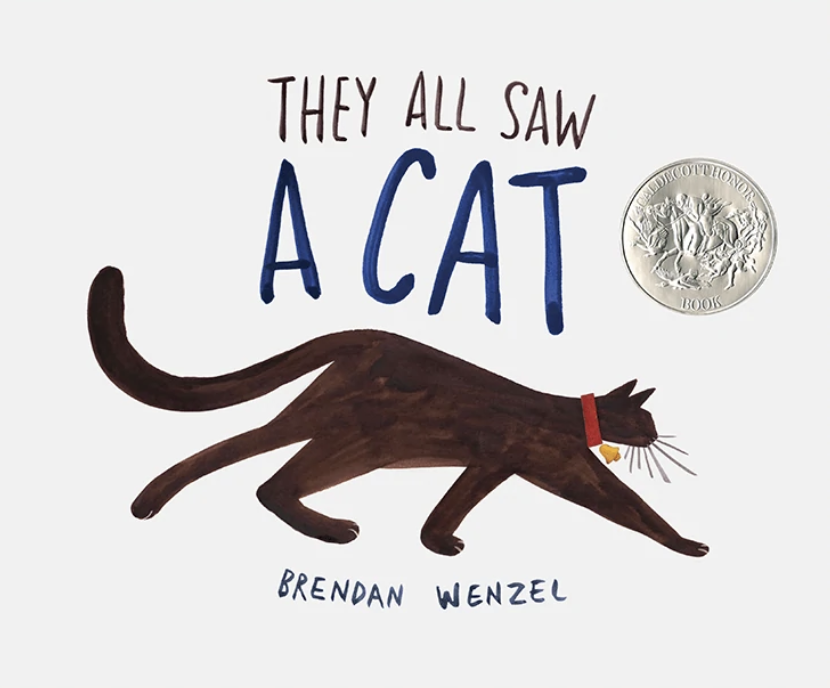They All Saw a Cat
Book Module Navigation
Summary
A cat walks through the world and is seen through the eyes of many other animals.
As a cat walks through the world, many others see it, such as a young child, a mouse, and a bird. Each animal, and the child, has a different image of the cat depending on their point of view. Eventually, the cat even sees its own reflection.
Read aloud video by simicrane
Guidelines for Philosophical Discussion
Throughout the story, the cat is seen from the perspective of many animals. Depending on which animal is viewing the cat, the image of the cat in the book is very different. For example, from the young child’s point of view, the cat looks soft and kind. From the mouse’s perspective, the cat looks large and dangerous. We use our senses to take in information and perceive the world. Sometimes perceptions are correct, but sometimes they are incorrect. For example, you may hear someone say “I hate cats” when they really say “I have cats.” How might our errors in perception impact how we see the world? How should we interpret the world if we are prone to perceptual errors? These ideas introduce students to further questions about how one’s position in the world impacts the way they see things and also allows children to consider other points of view.
Near the end of the book, the cat looks at its own reflection in the water, and sees itself differently than all of the other animals saw it. Is the cat’s perception of itself more accurate than the other animals’ perception of the cat? How does knowing about the way others perceive a person change their identity or sense of self? Perception and the errors of perception are also relevant to one’s sense of self. We take in information about ourselves and use it to form an understanding of our identities. This section questions what should be included in our identities and how one’s sense of self may be biased or inaccurate. The questions allow students to consider their own identities and how perception influences others and their own sense of self.
Each animal sees the cat differently, but it seems there should be a way the cat is. Independent of any interpretation, what is the cat like? Is there any way to find out? Is it important to know what the cat is really like? Many philosophers believe that there is not a good way of determining the objective truth. However, philosophers find it important to get as close to the truth as possible. Some philosophers believe that experience will get us closest to the truth, while some believe that reasoning and logic will get us closest to the truth. Does our perception of the cat make it true? Or is there a better way to find out what the cat is truly like? These questions explore accuracy of perception and allow students to consider what they know based on their experiences and what they may know objectively.
Questions for Philosophical Discussion
Outside Perception
- Why does the cat look different to each animal that sees it?
- How do you see the cat? Which animal did you agree with?
- Do you like cats? Do you think you see cats differently than someone who has the opposite opinion?
- Why does the cat change when we see it with the mouse and with the child?
- How does someone’s position/opinion change how they see other people?
- How does it change how they treat others?
- How does who you are affect how you see others and how others see you?
- Does it matter how others see us?
Sense of Self
- Near the end of the book, the cat looks at its own reflection. Do you think that the cat’s reflection is a true image of itself? Do you think the cat believes it is a more true image of itself?
- Do you think your reflection is a true image of yourself? Why?
- Do you think your idea of yourself is close to who you truly are? Why?
- Is there a difference between how we see ourselves and how others see us? Is one more important than the other?
- Can there be a difference between one’s identity and who they really are? Is this okay?
- At the end of the story, there is a picture of the cat that includes all of the ways others see it. Do you think that others’ perceptions should be included in someone’s identity? Why?
Truth/Objectivity
- Which version of the cat do you think is the most realistic and why?
- Do you think there’s any way to accurately portray the cat?
- Is there any feature of the cat that all of the other animals see in common? (e.g. a tail or ears)
- Is that feature of the cat more important than other features?
- If you take away the ears, is it still a cat?
- How can we get the best or most accurate understanding of ourselves? Should we try?







